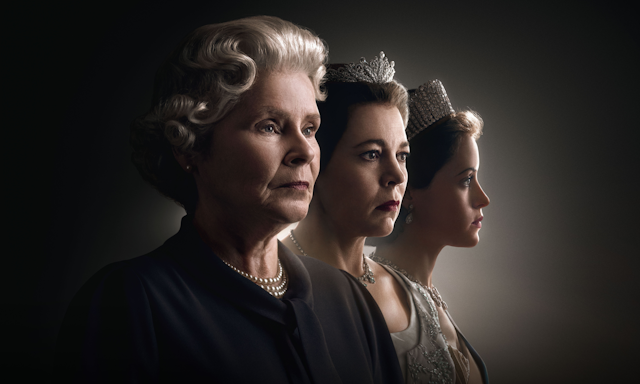As the 20th century drew to a close, support for the royal family was at a low ebb. This decline was precipitated by the separation of Prince Charles and Princess Diana in December 1992. That year also saw the publication of Andrew Morton’s Diana: Her True Story.
What Queen Elizabeth II called her “annus horribilis” (terrible year) was compounded by Prince Charles’s ITV interview with Jonathan Dimbleby (1994), in which he confessed to adultery, and by Diana’s tell-all conversation with the BBC’s Martin Bashir (1995).
In this controversial interview, Diana said:
I don’t think many people will want me to be queen. Actually, when I say many people I mean the establishment that I married into, because they have decided that I’m a non-starter.
Diana, now no longer in line to be Queen of England, resolved instead to be “queen of people’s hearts”. The huge outpouring of grief at her death in 1997 was testament to her success, prompting criticism of Elizabeth for her delayed public response.
The queen’s press secretary said at the time: “the Royal Family have been hurt by suggestions that they are indifferent to the country’s sorrow”. There followed a series of concessions. The queen agreed for the union jack to be flown at half-mast above Buckingham Palace. She returned to London from Balmoral and made a televised tribute to Diana’s life.
Nonetheless, the following year Ipsos recorded a temporary drop in satisfaction with the queen from 75% in 1992 to 66%.
This historical moment is central to the upcoming sixth and final season of Netflix’s The Crown. Portraying the death of Diana within the royal family is familiar ground for The Crown’s creator Peter Morgan, who first dealt with the aftermath of the tragedy in his script for The Queen (2006).
In that film, UK prime minister Tony Blair reassures Elizabeth that “when people come to assess your legacy, no-one will remember those few days”. He was proven right: in the queen’s Platinum Jubilee year (2022) she rode high in the Ipsos poll with 86% support.
My sense is that The Crown will amplify the broadly sympathetic portrayal of Morgan’s 2006 biopic. Supported by her popularity at her death, it will likely present the queen’s inaction in 1997 as a temporary misjudgement in a long life of public service.
A rebounding monarch
Elizabeth’s popularity was bolstered in the years between the release of The Queen and the finale of The Crown. This was partly due to a succession of milestones which encouraged public celebration of the royal family and its matriarch.
These include the royal weddings of 2011 and 2018, the televised christening of Prince George (2013) (the so-called “republican slayer”), and the queen’s Diamond (2012) and Platinum Jubilees.
These ceremonial events co-exist with lighthearted media appearances revealing the queen’s more playful side. The most memorable of these are her appearance opposite Daniel Craig’s James Bond in the opening ceremony to the 2012 Olympics, and opposite Paddington during the Platinum Jubilee.
Whereas the monarch’s apparently cool response to Diana’s death implied, according to a headline quoted in The Queen, that “the royals are not like us”, the last decade has stressed their accessibility. These fond cultural memories will form a vital counterpart to The Crown’s treatment of the queen’s brief fall from grace.
The Crown will also have to balance its tribute to Diana against the popular sense of Elizabeth’s exceptionalism, magnified by its own sustained attention to her life.
At the time of her death, even anti-monarchists expressed gratitude towards her, aside from the institution that she represented and that they despised. A contributory factor might have been her unusually long reign, which afforded her the time and space to learn from her mistakes.
For instance, as seen in the Aberfan episode of The Crown, the queen’s 1966 visit to the Welsh mining village after a landslide of coal killed more than 140 people was unaccountably delayed. However, in 2017 her timely visit to survivors of the Grenfell tower fire contrasted with her belated response both to Aberfan and to Diana’s mourners, showing that she had changed.
A nation grieves
Lastly, the queen acted as a focal point during the pandemic, when her special broadcast reassured the lonely that “we will meet again”. Her own isolation at her husband’s funeral in 2021, where she was filmed sitting alone, symbolised the widespread adherence to COVID restrictions – in this sad and quiet moment she was suffering with and like her people.
The phenomenon of collective grief suggests that she may have stood, for some, for our own pandemic losses. Indeed, when The Crown shows the people taking to the streets for Diana, it is the mass turnout for the queen’s funeral procession that many viewers will recall.
While mourning Diana as “the people’s Princess”, the series will likely end with Queen Elizabeth as the ultimate queen of hearts.

Looking for something good? Cut through the noise with a carefully curated selection of the latest releases, live events and exhibitions, straight to your inbox every fortnight, on Fridays. Sign up here.

